The Serverless Apps Market is estimated to be valued at USD 18.3 billion in 2025 and is projected to reach USD 149.9 billion by 2035, registering a compound annual growth rate (CAGR) of 23.4% over the forecast period.
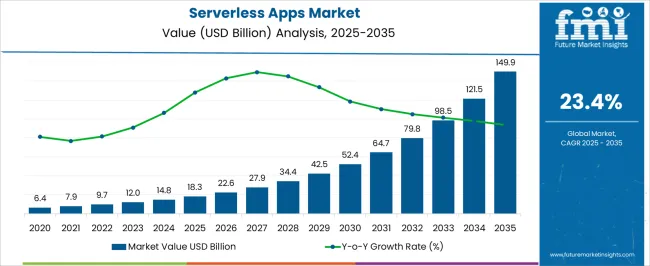
| Metric | Value |
|---|---|
| Serverless Apps Market Estimated Value in (2025 E) | USD 18.3 billion |
| Serverless Apps Market Forecast Value in (2035 F) | USD 149.9 billion |
| Forecast CAGR (2025 to 2035) | 23.4% |
The serverless apps market is experiencing accelerated adoption due to the growing enterprise focus on operational scalability, cost optimization, and faster application deployment cycles. Organizations are increasingly shifting from traditional server-based architectures to function-as-a-service (FaaS) models to reduce infrastructure overhead and improve agility.
This transition is being enabled by enhancements in cloud-native environments, microservices orchestration, and event-driven architecture compatibility. Vendors are continuously strengthening their platform ecosystems with AI-enabled development tools, auto-scaling capabilities, and tighter DevOps integration, further promoting the adoption of serverless frameworks.
The need for real-time analytics, container-less execution, and reduced time-to-market for software releases is fueling demand across sectors. Moving forward, the market is expected to benefit from hybrid deployment models, API-centric development, and compliance-ready serverless platforms tailored for regulated industries.
The market is segmented by Application, Enterprise Size, and Industry and region. By Application, the market is divided into Real-Time File/Stream Processing, Web Application Development, IoT Backend, and Others. In terms of Enterprise Size, the market is classified into Large Enterprises and SMEs. Based on Industry, the market is segmented into IT and Telecommunication, BFSI, Retail, Government, Manufacturing, and Others. Regionally, the market is classified into North America, Latin America, Western Europe, Eastern Europe, Balkan & Baltic Countries, Russia & Belarus, Central Asia, East Asia, South Asia & Pacific, and the Middle East & Africa.
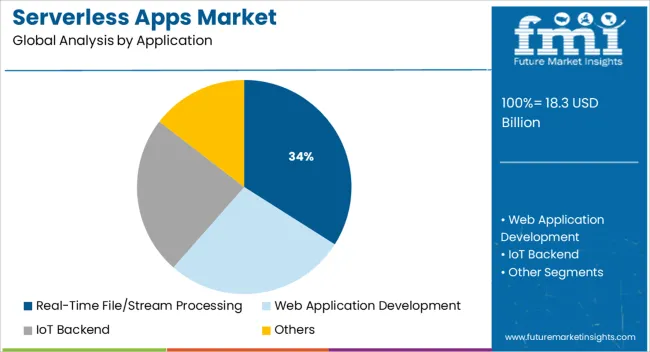
Real-time file and stream processing applications are projected to account for 34.0% of total revenue in the serverless apps market by 2025, making this the dominant application segment. This position is being supported by the increasing demand for high-velocity data handling and instant processing across cloud-based analytics and monitoring systems.
The proliferation of IoT devices, continuous data pipelines, and user interaction logs has required more dynamic and scalable backend processing frameworks. Serverless architectures offer ideal responsiveness and horizontal scalability for such workloads without the need for provisioning or pre-configuration.
As businesses prioritize real-time decision-making and customer experience enhancements, adoption of serverless stream processing continues to grow, especially in sectors handling large volumes of unstructured data.
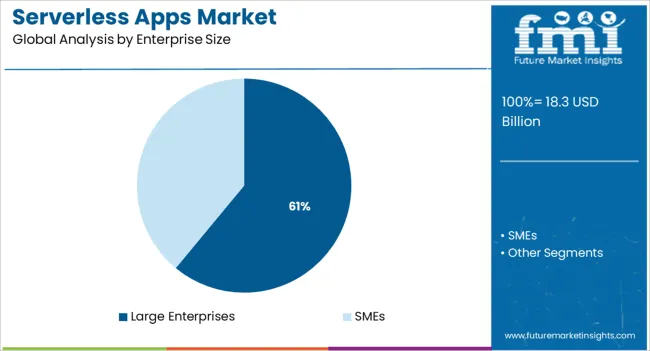
Large enterprises are expected to hold 61.0% of the total market share in 2025, establishing them as the primary users of serverless apps. This leadership is attributed to the complex application ecosystems, global workloads, and heavy DevOps investments maintained by these organizations.
Serverless platforms are enabling cost control and workload distribution across multiple geographies, which aligns well with enterprise-scale digital transformation strategies. The flexibility to deploy event-driven logic, support legacy modernization, and automate routine processes through serverless functions has further strengthened uptake in large-scale enterprises.
Moreover, the capacity for granular usage-based billing has made these platforms more attractive from an operational expenditure perspective, especially for high-volume, performance-sensitive applications.
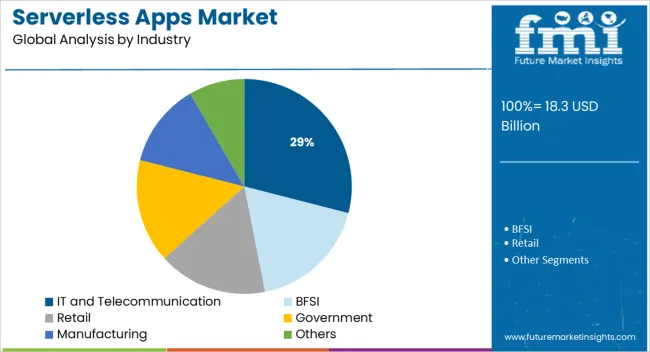
The IT and telecommunication industry is projected to contribute 29.0% of the overall revenue in 2025, positioning it as the leading vertical for serverless apps adoption. This trend is being driven by the need for low-latency processing, agile development cycles, and continuous software delivery within telecom and tech organizations.
The high volume of service requests, application updates, and customer interactions necessitates backend solutions that scale instantly and integrate with APIs, cloud databases, and message queues. Serverless computing provides these capabilities with minimal infrastructure complexity, allowing IT teams to focus on code delivery and application logic.
Additionally, the rise of edge computing and 5G infrastructure has created new use cases that benefit from event-triggered, distributed serverless functions, reinforcing adoption within the sector.
One of the most important benefits offered by serverless apps is the cost savings, mainly when differentiated from other cloud services. The serverless computing model not only pays for what users use but this model permits users to lower the price related to access authorization, presence detection, image processing, security, and more.
Software container technology powers serverless technology. Because the sellers control them, though it is invisible to the users. This permits serverless computing to manage the benefits of containerized microservices without complication. Thus, the technology present in serverless apps helps to maintain the operational functions of the serverless apps. Thus, the reduced development and operational costs are driving the serverless apps market demand.
Explanation of Preview Image:
Due to the presence of significant players t, the serverless apps market in the North American region is reportedly relatively mature. The serverless apps market is reaching maturity in the Europe region as a result of the growing usage of serverless apps in the retail sector. Because of the growing need for serverless apps across many industry verticals, including BFSI, telecom, and retail, the market for serverless apps in South Asia and the Pacific is currently in its growth maturity period.
The serverless apps market demand is expected to increase at 23.4% CAGR between 2025 and 2035 in comparison with the 21.3% CAGR registered from 2020 to 2024. With the quick technological shift in the business environment, companies are launching new products and services thus concentrating on reduced time to market to meet the exponentially increasing consumer expectations. The growing importance of such trends is expected to drive the serverless apps market during the predicted period.
In the competitive marketplace, startups are expected to scale quickly and provide enhanced features for their products and services, thus enhancing their business values. Therefore, in order to attain minimum lead time and positively influence their business, they are expected to adopt serverless technology (serverless apps).
Serverless architecture has appeared as an inventive step in leveraging cloud-based technologies to their full potential thus permitting enterprises to concentrate on their core product and services, instead of managing the traffic or load on their IT infrastructure. Thus, all these factors are driving the serverless apps market demand during the forecast period.
The demand for mobile-based applications for businesses to connect with their clients is becoming more and more frequent, mainly with the growing usage of smartphones worldwide. Many businesses are shifting to applications as means to communicate with their customers and employees, and telecom companies are in a position to offer a service that answers this requirement.
Telecom companies can utilize serverless computing technology and serverless apps to develop improved serverless offerings that improve connectivity and offer cost-efficient applications that are fast and reliable to deploy.
By offering consumers with these kinds of improved services telecom operators can compare themselves in a very congested market. This kind of service offering could be a crucial factor for consumers choosing a service provider. Thus, the continuous increase in the adoption of cloud technology with the usage of serverless apps in IoT technology is expected to boost the development of the serverless apps market development.
North America region is dominating the worldwide market with a share of around 32.9% in the year 2024. On the other hand, South Asia and the Pacific region are estimated to register strong growth in the market, exhibiting a CAGR of around 22.5% during the predicted period.
Moreover, Europe is estimated to be the second fastest-growing region in the serverless apps market. This region is predicted to grow with a market share of around 20.7% during the forecast period. In the European region due to the rapid advancement in technologies and the presence of several crucial players and the growing adoption of serverless apps among various industry verticals are expected to dominate the market.
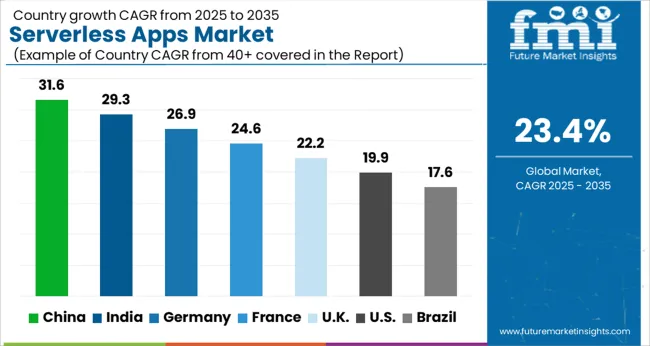
Increasing adoption of new cloud computing services and because of the high digitalization these factors contributing to the serverless apps market growth. Various benefits offered by serverless apps like reduction in price, simpler configuration, and hassle-free troubleshooting of the server differentiated from the conventional approach are expected to increase the market development. Due to these factors, sales in India are predicted to increase at the CAGR of 24.1% during the predicted period 2025 to 2035.
Increasing awareness about the advantages of serverless apps, like enhanced procedure agility and lower operational price, is one of the major factors driving the market growth in Germany. Other advantages offered by serverless apps such as faster setup, simpler operational management, and zero system administration are also the major drivers for the market development of the serverless apps market. According to the analysis, the nation held close to 12.5% of the market share for the region of Europe in 2024.
In the market for serverless apps, the USA held a 23.4% share of the North American market in 2024. The development of cloud-based technologies and third-party agents to control server components, as well as the presence of significant suppliers in the North American region is expected to drive the market growth.
Many American businesses have started using serverless apps because they may save time and expensive traditional processes like buying new hardware components, configuring, installing, and debugging. As a result, the benefits provided by serverless apps are fueling the market.
Real-time data streaming involves ingesting and collecting a sequence of data from several data sources and processing that data in real-time to extract insight and meaning. Real-time data streaming permits users to process and analyze data in real-time instead of waiting hours, weeks, or days.
Thus, the advantages offered by serverless apps are driving market growth. As a result, real-time file/stream processing accounted for 39.3% market share of the application segment in 2024.
Due to the rising demand for cloud automation, serverless apps are widely adopted by major businesses, and this trend is anticipated to continue over the forecasted period. Large businesses are heavily investing in cutting-edge technology to boost overall production and efficiency.
Due to the ever-increasing volume of data, large businesses need to invest in IT infrastructure and have the necessary technological know-how to routinely automate a number of processes. Thus, serverless apps are highly utilized in large enterprises because of the benefits offered by serverless apps. The large enterprise segment held a 62.7% market share of the enterprise size segment in 2024.
Serverless applications fulfill various regulatory standards and constantly shift consumer expectations in the BFSI industry. Real-time applications are supported by serverless architecture, which also offers a scalable and secure platform for offering real-time information as needed by the BFSI sector. As a result, the BFSI industry offers vendors in the serverless apps market better development opportunities. As per the analysis, the BFSI segment is expected to grow at a CAGR of 17.3% during the forecast period from 2025 to 2035.
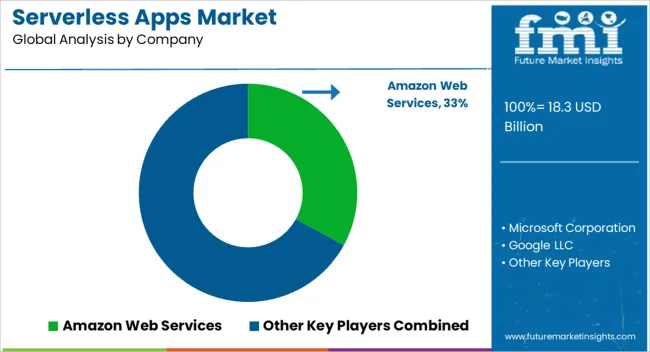
Serverless apps market major vendors are concentrating on strategic partnerships with other important players to develop technologically advanced serverless apps for several applications to serve their consumers.
| Attribute | Details |
|---|---|
| Market value in 2025 | USD 18.3 billion |
| Market CAGR 2025 to 2035 | 23.4% |
| Share of top 5 players | Around 35% |
| Forecast Period | 2025 to 2035 |
| Historical Data Available for | 2020 to 2024 |
| Market Analysis | USD Million for Value |
| Key Regions Covered | North America; Latin America; Europe; East Asia; South Asia & Pacific; and the Middle East & Africa |
| Key Countries Covered | USA, Canada, Germany, United Kingdom, France, Italy, Spain, Russia, China, Japan, South Korea, India, Malaysia, Indonesia, Singapore, Australia & New Zealand, GCC Countries, Turkey, North Africa, and South Africa |
| Key Segments Covered | Application, Enterprise Size, Industry, and Region |
| Key Companies Profiled |
Amazon Web Services; Microsoft Corporation; Google LLC; IBM Corporation; Cisco Systems, Inc.; Oracle Corporation; Rackspace Technology; TIBCO Software Inc.; Serverless, Inc.; Cloudflare, Inc.; Netlify; NTT Data Corporation; Apache; Palo Alto Networks; Twistlock Inc. |
| Report Coverage | Market Forecast, Company Share Analysis, Competition Intelligence, Drivers, Restraints, Opportunities and Threats Analysis, Market Dynamics and Challenges, and Strategic Growth Initiatives |
| Customization & Pricing | Available upon Request |
The global serverless apps market is estimated to be valued at USD 18.3 billion in 2025.
The market size for the serverless apps market is projected to reach USD 149.9 billion by 2035.
The serverless apps market is expected to grow at a 23.4% CAGR between 2025 and 2035.
The key product types in serverless apps market are real-time file/stream processing, web application development, IoT backend and others.
In terms of enterprise size, large enterprises segment to command 61.0% share in the serverless apps market in 2025.






Full Research Suite comprises of:
Market outlook & trends analysis
Interviews & case studies
Strategic recommendations
Vendor profiles & capabilities analysis
5-year forecasts
8 regions and 60+ country-level data splits
Market segment data splits
12 months of continuous data updates
DELIVERED AS:
PDF EXCEL ONLINE
Super Apps Market Size and Share Forecast Outlook 2025 to 2035
Event Apps Market Analysis – Size, Trends & Forecast 2025 to 2035
Fitness Apps Market Report - Trends & Forecast 2025 to 2035
P2P Rental Apps Market Size and Share Forecast Outlook 2025 to 2035
In Vehicle Apps Market Size and Share Forecast Outlook 2025 to 2035
NFT Lending Dapps Market Size and Share Forecast Outlook 2025 to 2035
Parking Meter Apps Market Size and Share Forecast Outlook 2025 to 2035
Parking Finder Apps Market Size and Share Forecast Outlook 2025 to 2035
Health Coaching Apps Market Growth – Trends & Forecast 2025 to 2035
Expense Tracker Apps Market Growth – Trends & Forecast 2025 to 2035
Digital Journal Apps Market Trends - Growth & Forecast 2025 to 2035
Fertility Tracking Apps Market
Blockchain Messaging Apps Market Size and Share Forecast Outlook 2025 to 2035
Digital Health Tracking Apps Market - Wearables & AI Trends 2025 to 2035

Thank you!
You will receive an email from our Business Development Manager. Please be sure to check your SPAM/JUNK folder too.
Chat With
MaRIA